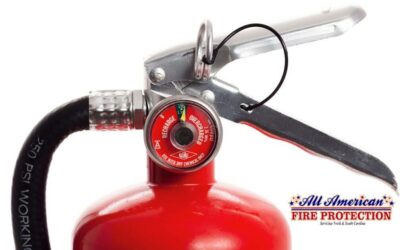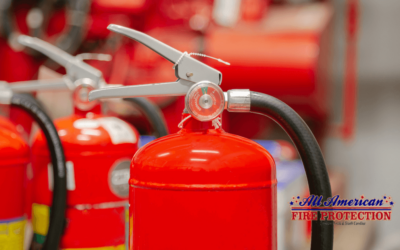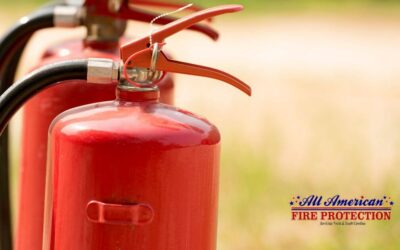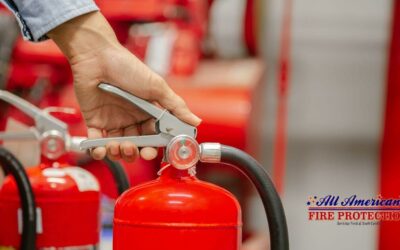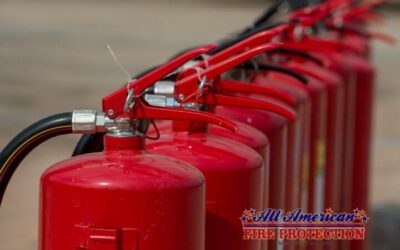Understanding Fire Extinguisher Disposal
Navigating the complexities of fire extinguisher disposal is essential for safeguarding the environment, adhering to legal mandates, and maintaining safety standards. This segment will explore the intricacies of properly discarding fire extinguishers, underscoring the necessity of grasping the appropriate procedures and regulatory requirements. Companies like All American Fire Protection, which specializes in fire extinguisher services, play a vital role in ensuring that these devices are not only available and functional when needed but also disposed of correctly to prevent environmental harm and comply with regulations.
Reasons for Disposal
Fire extinguishers may need to be discarded for a multitude of reasons. A primary factor is the lifespan of the device; once an extinguisher surpasses its serviceable duration, its reliability and effectiveness in emergencies are no longer assured. Visible signs of deterioration, such as corrosion, dents, or leaks, signal that the unit is no longer fit for use and should be responsibly eliminated to prevent any chance of failure when it’s most needed.
Post-use scenarios also prompt disposal. Extinguishers that have been activated, whether partially or completely, might not be suitable for recharging or may not justify the expense of servicing. It’s imperative to dispose of these units to guarantee the availability of a fully operational extinguisher at all times.
Inspections might reveal hidden internal damage or corrosion that could compromise the extinguisher’s functionality. Given the high-pressure nature of their contents and the potentially hazardous chemicals involved, any structural weakness could present a serious risk. Should an extinguisher not pass these rigorous checks, it must be replaced, and the compromised one disposed of correctly.
As fire safety standards evolve, older models may no longer conform to the latest safety requirements. Transitioning to newer, more effective models that align with current regulations requires the responsible disposal of the antiquated units.
Finally, an organization may decide to discard extinguishers if they transition to a different model better suited to their specific fire hazards or operational requirements. Given that each type of extinguisher demands a distinct disposal approach, it’s crucial to be well-informed about the specific disposal guidelines for each kind.
Types of Fire Extinguishers and Disposal Methods
The variety of fire extinguishers available is tailored to combat different fire classes, and this diversity necessitates specific disposal techniques:
- Water and Foam Extinguishers: These units, when no longer serviceable, should be fully discharged to ensure no pressure remains. While water poses minimal environmental risk, foam solutions require careful disposal to prevent contamination of aquatic ecosystems.
- Carbon Dioxide (CO2) Extinguishers: Once emptied, the high-pressure cylinders of CO2 extinguishers, typically constructed from aluminum or steel, are perfect candidates for metal recycling. The release of any remaining CO2, however, should be managed by professionals to mitigate safety risks.
- Dry Chemical Extinguishers: Housing various powders such as monoammonium phosphate or sodium and potassium bicarbonate, these canisters, if devoid of contents, are recyclable. Remaining powder must be discharged in an environmentally safe manner due to its potential impact on the environment.
- Wet Chemical Extinguishers: Commonly employed for kitchen fires, these devices contain a soap-like solution that must be disposed of as hazardous waste. The metallic components can be salvaged and recycled.
- Metallic Sodium or Potassium (Class D extinguishers): Given the highly reactive extinguishing agents within, these extinguishers demand specialized disposal procedures. Waste management experts with experience in Class D agents should be consulted.
- Halon and Halotron (Clean Agent Extinguishers): Despite their effectiveness, these extinguishers are being phased out to protect the ozone layer. Specialized reclaiming and recycling programs are in place for these substances, which must be handled by certified facilities.
For each extinguisher type, adherence to local environmental regulations is non-negotiable. Seeking advice from local fire authorities, waste disposal services, or professional disposal companies ensures that disposal practices meet all regulatory standards.
Environmental and Legal Considerations
The disposal of fire extinguishers intersects with environmental protection and legal compliance. Chemicals such as halon and certain dry chemical powders, if mishandled, can inflict serious harm on ecosystems, contaminating soil and water and thereby threatening wildlife and human health.
In the U.S., the Environmental Protection Agency (EPA) sets forth guidelines that are essential to follow to mitigate environmental harm. Globally, similar regulations exist, mandating strict adherence to prevent ecological damage and protect public welfare.
Legally, failure to comply with disposal regulations can lead to significant penalties, including fines or criminal charges. The Resource Conservation and Recovery Act (RCRA) exemplifies U.S. legislation that oversees the proper management of hazardous waste. Businesses are obligated to maintain documentation of their disposal practices, which serves as evidence of compliance during regulatory reviews or audits.
In situations where uncertainty prevails or when dealing with substantial quantities of extinguishers, engaging a licensed hazardous waste management firm is a prudent choice. These experts are equipped to manage, transport, and dispose of hazardous materials in compliance with all regulations.
By taking into account these environmental and legal factors, businesses not only avert potential penalties but also contribute to a healthier, more sustainable environment.
Preparing for Disposal
Embarking on the disposal of outdated fire extinguishers requires meticulous preparation to ensure adherence to safety protocols and regulatory mandates. The following steps are pivotal in readying extinguishers for proper disposal:
Checking Pressure and Discharge
The initial phase in preparing an extinguisher for disposal is to verify its pressure status. Extinguishers equipped with gauges offer a visual cue; a needle in the green zone signifies internal pressure, necessitating discharge. In contrast, a gauge reading low or empty suggests an absence of pressure, yet this should be confirmed to account for potential gauge inaccuracies.
Discharging an extinguisher must be conducted with precision, in an environment where the agent can be released without causing ecological damage or endangering human health. The ideal scenario involves directing the extinguisher’s contents into a designated containment system capable of securing the released substance.
For those extinguishers that defy easy assessment or discharge, or for individuals seeking to avoid personal risk, the expertise of local fire authorities or fire safety professionals offers a secure alternative. Their specialized equipment and knowledge ensure complete depressurization and agent release, preparing the extinguisher for the next stage of disposal.
Different agents necessitate distinct discharge techniques, as previously outlined in the section on disposal methods. For instance, the release of a carbon dioxide extinguisher contrasts with that of a water-based model, with each type bearing unique environmental considerations.
Once an extinguisher has been successfully depressurized and its contents discharged, it should be conspicuously marked to reflect its empty status. This precaution prevents potential confusion or inadvertent deployment during subsequent handling and disposal.
In essence, confirming the absence of pressure and executing a safe discharge are critical steps that prime extinguishers for disposal, mitigating risks to both individuals and the environment.
Labeling and Documentation
Following depressurization and discharge, it’s imperative to label the extinguisher clearly, indicating that it has been rendered safe for transport. This step distinguishes it from those still containing pressurized agents, thereby eliminating the hazard of accidental discharge during transit.
Documentation serves as the cornerstone of the disposal process, especially for businesses. A detailed record should include the extinguisher type, the method of disposal, and the final destination for the extinguisher’s components. Such meticulous record-keeping provides a traceable path for regulatory compliance and environmental stewardship.
It’s also prudent to consult local regulations regarding disposal preparation, as some jurisdictions may impose specific requirements, such as accompanying forms or certifications.
By diligently adhering to these preparatory measures, one can navigate the complexities of extinguisher disposal with confidence, ensuring a process that is both safe and environmentally sound.
Labeling and Documentation
Once a fire extinguisher is fully depressurized and confirmed to be empty, the next critical step is to label and document it appropriately. This ensures a secure and lawful disposal process.
Labeling: Attach a conspicuous label or tag to the extinguisher, indicating that it has been discharged and is out of commission. This label acts as a clear signal to prevent any potential reuse or mishandling during the subsequent disposal stages.
Documentation: Keeping a detailed record of the disposal process is a regulatory necessity. This record should encapsulate the following details:
– The specific date and individual responsible for discharging the extinguisher.
– A clear identification of the extinguishing agent contained within.
– The disposal method implemented.
– The extinguisher’s final destination, particularly if it’s being transported for off-site disposal.
For entities such as businesses, maintaining these records is a pivotal component of their fire safety and environmental protocols. Such diligence aids in regulatory audits and serves as evidence of proper disposal in the event of environmental scrutiny.
Adherence to environmental regulations, as previously outlined, is reinforced through meticulous documentation. In certain localities, specific forms or certificates may be required to confirm the environmentally sound and lawful disposal of fire extinguishers. It’s prudent to consult with local environmental authorities to ensure all paperwork is complete and accurate.
By rigorously attending to labeling and documentation, one can guarantee that the disposal process is transparent, accountable, and aligns with all relevant environmental and legal standards.
Disposal Options
With your fire extinguisher now depressurized, discharged, and suitably labeled and documented, you’re ready to explore the avenues available for its final disposal.
Disposal Facilities and Programs
Seek out local government or environmental agencies for advice on disposal facilities equipped to handle fire extinguishers. These facilities often include hazardous waste collection centers specifically designed for such items. Additionally, look for community hazardous waste collection events, which provide an opportunity to safely relinquish your fire extinguisher.
Consulting your local fire department can also yield valuable information. They may accept extinguishers for disposal or provide guidance to a certified facility. Policies can differ, so a preliminary phone call is recommended to confirm their current practices.
Professional Disposal Services
For those facing the challenge of disposing of large or numerous fire extinguishers, professional disposal services offer a viable solution. These companies are adept at managing the collection, transport, and disposal of hazardous materials, ensuring compliance with local regulations.
These services are particularly beneficial for businesses tasked with disposing of multiple units or those containing complex agents requiring specialized handling. They also provide certificates of disposal, which are essential additions to your documentation for maintaining regulatory compliance and for future reference.
Whichever path you choose, it’s imperative to proceed with a disposal method that is responsible, environmentally sound, and adheres to all local regulatory requirements.
Disposal Facilities and Programs
Navigating the disposal of an outdated fire extinguisher can be streamlined with the assistance of local disposal facilities and recycling initiatives. These entities play a pivotal role in ensuring the process adheres to safety and legal standards.
Your area’s municipal waste facilities typically offer specific guidance on extinguisher disposal, tailoring their advice to the needs of both residential and commercial entities. Given the diversity in extinguisher types and sizes, the regulations may differ, and these facilities can provide the most current and relevant information.
Recycling programs are another valuable resource, focusing on the reclamation of materials such as metals from extinguishers. Prior to dropping off your extinguisher, it’s crucial to confirm with these programs whether they accept extinguishers and any necessary preparatory steps they require.
Occasionally, local environmental or health departments may host hazardous waste collection events. These events provide a safe avenue for disposing of extinguishers and other hazardous items, ensuring they are treated with the utmost care for the environment.
Consulting with your local fire department can also yield useful information. While they may not manage disposal directly, they often can direct you to the appropriate local resources.
When transporting your extinguisher to a disposal site, ensure it has been depressurized and discharged as previously outlined, and that it is clearly labeled, following the guidelines discussed earlier. This preparation aids the facility staff in identifying the extinguisher as ready for safe disposal.
By leveraging these local resources and adhering to established guidelines, you contribute to a disposal process that mitigates potential environmental or health risks, responsibly concluding the extinguisher’s lifecycle.
Professional Disposal Services
For those who face the task of disposing of multiple extinguishers, particularly large or hazardous ones, enlisting a professional disposal service can be an invaluable option. These experts handle the process from start to finish, ensuring compliance with all relevant regulations—a critical consideration for businesses governed by stringent waste disposal protocols.
When choosing a service provider, it’s essential to confirm their certification for fire extinguisher disposal, particularly since some extinguishing agents are considered hazardous waste. A reputable service will adhere to all local, state, and federal regulations and provide you with documentation confirming the proper disposal of your extinguishers.
These professionals typically offer a comprehensive service that includes on-site pick-up and takes care of:
– Safely evacuating any remaining pressure, a process that aligns with the steps previously discussed.
– Properly disposing of any leftover extinguishing agent in an environmentally responsible manner.
– Dismantling the extinguisher for component recycling when possible.
– Issuing certificates of disposal or recycling for your records.
By partnering with a professional disposal service, you not only ensure that your extinguishers are disposed of in an environmentally conscious way, but you also alleviate the burden of navigating the complex disposal process. The documentation they provide will be a valuable addition to your records, ensuring you maintain compliance with all necessary disposal protocols.
Engaging with these specialists offers the assurance that your fire extinguishers are in capable hands, allowing you to focus on your core responsibilities with confidence that the disposal aspect is being managed professionally.
Safety Precautions for DIY Disposal
Embarking on the do-it-yourself route for fire extinguisher disposal necessitates a strict adherence to safety protocols to mitigate any risks of injury or environmental damage. Key steps in this process include:
Commence by confirming the extinguisher is devoid of pressure, a critical step that ensures safety, as detailed in the ‘Checking Pressure and Discharge’ section. A charged extinguisher can be hazardous if compromised.
Don protective attire, such as safety goggles, durable gloves, and clothing that covers the arms and legs, to shield yourself from any contact with the extinguishing agent, especially those of a chemical composition.
Select an area that is spacious and well-aerated, preferably outdoors, for the release of the extinguisher’s contents. It’s essential to ensure that this area is clear of any ignition sources to prevent any potential hazards.
Exercise environmental caution by discharging the extinguisher into a receptacle that will prevent any seepage into the soil or water systems, in line with the environmental guidelines previously discussed.
Should you face any challenges, like a non-responsive pressure gauge or an inability to expel the contents, it’s imperative to cease your efforts and seek expert advice. Reach out to local waste management entities, fire safety officials, or specialized disposal services for support.
Once emptied, the extinguisher’s shell should be disposed of or recycled following the protocols of your local recycling center. If recycling, dismantle any non-metal components and ensure the metal is sorted correctly.
Adherence to local ordinances is crucial. As emphasized in ‘Disposal Facilities and Programs’, flouting these regulations can result in legal consequences and environmental repercussions.
By observing these precautionary measures, you can dispose of your fire extinguisher responsibly, prioritizing both personal safety and the preservation of the environment.
After Disposal: Records and Replacement
Post-disposal, it’s essential to manage the administrative aspects and promptly address the need for replacement units to ensure continued fire safety.
Document every aspect of the disposal process, retaining all related paperwork such as certificates or disposal receipts. This record-keeping, integral to the ‘Labeling and Documentation’ process, serves as evidence of your compliance with disposal regulations and will be indispensable for future audits. Secure these documents for the duration mandated by local authorities, typically spanning several years.
Simultaneously, address the need for new fire extinguishers to fill the void left by the discarded units. Acquire replacements promptly, selecting models suited for the specific fire hazards they are intended to counter. Install these new units in accordance with both the manufacturer’s guidance and prevailing safety regulations.
This juncture also presents an opportunity to reassess your fire safety protocol. Update all team members on the new equipment and ensure they are proficient in its operation. Regular drills and reviews of emergency procedures are vital components of a robust fire safety plan.
Incorporate the details of the disposal and replacement process into your fire safety inventory logs. This record should encompass the identification of the retired units, the date they were disposed of, and the specifics of the new extinguishers, including their installation dates.
By diligently following these steps, you maintain the efficacy of your fire safety measures, create a transparent record for compliance purposes, and guarantee that your premises remain safeguarded against fire hazards.


